Third-Gen ATI FireGL Boards Worth the Wait
New AMD V-series of ATI workstation graphics accelerators provide twice as much memory and three times the performance.
December 4, 2001
By David Cohn
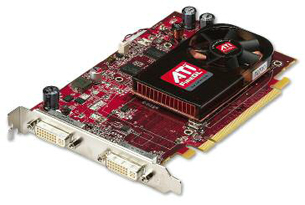 The entry-level ATIFireGL V3600. |
ATI has long been a leader in workstation graphics. In 2004, the company was the first to announce PCI Express-based boards, with the introduction of its FireGL Visualization series. In 2006, ATI became the first company to introduce a workstation-class graphics accelerator with 1GB of onboard memory, as part of its second generation of FireGL V series graphics boards (which we reviewed in the July 2006 issue of DE). But shortly thereafter, Ontario-based ATI was acquired by Advanced Micro Devices (AMD). The company’s headquarters moved to Sunnyvale, California, and it would be more than a year before AMD would update its ATI workstation graphics accelerators.
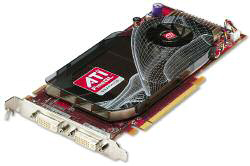 The mid-range ATI FireGL V5600. |
It was worth the wait. The five high-performance graphics boards are based on a new generation ATI graphics processing unit (GPU) designed around a unified shader architecture. Like the NVIDIA Quadro FX boards we recently reviewed, ATI’s unified graphics architecture replaces dedicated geometry engines and pixel shaders with what the company calls Stream processing units. Rather than having pixel shaders sitting idle while geometry engines are maxed out dealing with the large number of polygons in typical CAD models, or pixel shaders working overtime handling textures in a typical low-polygon DCC (digital content creation) image, the Stream processors can dynamically handle geometry or shading tasks as necessary.
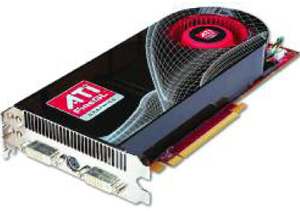 The high-end ATI FireGL V7600. |
According to AMD, the end result is as much as a 300 percent performance improvement compared to the company’s previous generation of product.
Connectivity
The new FireGL V-series graphics accelerators also offer AMD’s new AutoDetect feature, which optimizes the graphics driver based on the user’s specific software applications even while running multiple programs simultaneously. With AutoDetect, users no longer need to manually adjust application-specific driver settings to achieve top performance.
All five boards in the new generation FireGL V-series are designed with a 10-bit display pipeline and support for high dynamic range (HDR) output, enabling the boards to produce more than one billion colors. All five boards also feature two Dual Link enabled DVI outputs and support up to four 3D displays (using multiple cards). And, like the most recent NVIDIA boards, the new ATI FireGL V-series boards are now Shader Model 4.0 compliant, can support hardware acceleration of DirectX 10 and OpenGL 2.1 advanced features, and come with the increased frame buffer capacity needed to make them fully Microsoft Vista ready. However, only two of the new ATI boards, the FireGL V3600 and V5600, are PCI Express 2.0 compatible.
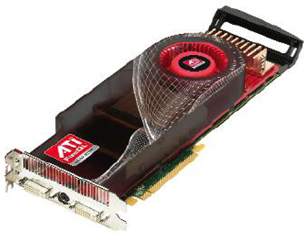 The ultra high-end ATI FireGL V8650, the industry’s first 2GB graphics accelerator, is otherwiseidentical to the V8600. |
In addition, all of the new boards with the exception of the entry-level FireGL V3600 sport a pair of ATI Crossfire 2.0 compatible connectors. Like NVIDIA’s SLI, Crossfire provides multi-GPU connectivity, but while Crossfire is enabled on ATI’s gaming boards (such as the Radeon HD 3870 cards in the Alienware system we recently reviewed; see July 2008 DE), ATI does not yet support Crossfire on its FireGL boards. That’s not really an issue, however, since multi-GPU connectivity is not widely used in typical workstation applications.
The New ATI FireGL V Family
At the entry level, the new ATI FireGL V3600 ($249 manufacturer’s suggested retail price (MSRP)/$179 average street price) provides 256MB of GDDR4 memory with a 128-bit ring-bus memory controller, twice the amount of memory of the previous generation FireGL V3400. The board’s next generation GPU features 120 unified shader processors (compared to 5 parallel geometry engines and 12 pixel shader processors in the V3400) and a memory bandwidth of 16.0GBps. The FireGL V3600 requires a single PCI Express X16 slot and consumes less than 50 watts of power.
As mentioned, both DVI-I ports support Dual Link, whereas only one DVI port on the V3400 supported ultra high-resolution displays. But unlike the older generation board it replaces, the FireGL V3600 (as well as the new mid-range V5600) lacks HD component video support.
For the mid-range, AMD introduces the ATI FireGL V5600 ($599 MSRP/$440 street). This board also doubles the amount of memory to 512MB, while retaining the same 120 stream processing units and 128-bit memory interface as its sibling. The memory bandwidth increases to 35.0GBps, however, while maintaining the same small form factor and keeping power consumption below 75 watts.
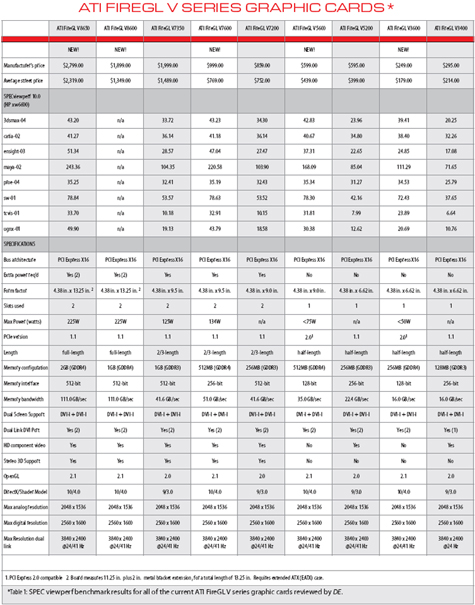 |
The new FireGL V7600 ($999 MSRP/ $770 street) is ATI’s new high-end graphics accelerator, essentially replacing the extremely popular V7200. With 512MB of GDDR4 memory (double its predecessor) and a 256-bit ring-bus memory controller, the V7600 uses 320 unified shader processors (compared to 8 dedicated geometry engines and 16 pixel processors in the V7200). The FireGL V7600 offers a memory bandwidth of 51 GBps and provides both HD component video and stereo 3D support, but all this power comes at the expense of higher energy consumption.
The V7600 consumes 134 watts, requiring the use of an auxiliary connection to the system power supply. The V7600 also has a large cooling fan that increases the overall thickness of the 2/3-length board to more than an inch, rendering the adjacent expansion slot unavailable.
At the ultra-high end, AMD introduces the FireGL V8600 ($1,899 MSRP/$1,349 street). Like the V7600, the board’s GPU provides 320 unified shader processors, but uses a 512-bit ring bus memory architecture and double the memory of both the V7600 and the older V7300 that it replaces.
Rather than send us a V8600, however, AMD elected instead to provide its top-of-the-line ultra high-end graphics accelerator, the new FireGL V8650 ($2,799 MSRP/$2,319 street), a card with the distinction of being the industry’s first 2GB workstation graphics accelerator.
Other than the amount of onboard GDDR4 memory, the V8600 and V8650 are nearly identical. Both use the same GPU, provide a memory bandwidth of 111GBps, and should deliver similar performance. But both also consume a whopping 225 watts of power, necessitating not one but two auxiliary connections to the system power supply. The large cooling fan and heat sink make these boards 1.5-inches thick, completely blocking the adjacent expansion slot, while the 13.25-inch overall length means that you can only squeeze these boards into extended ATX cases.
Benchmarking the Boards
We tested the four ATI FireGLs we received using the same HP xw6600 workstation equipped with a pair of 3.0GHz Quad-Core Xeon E5450 processors, so all of our results are directly comparable. (DE reviewed this system in the April 2008 issue.) This is the same system we used to review the new NVIDIA Quadro FX boards in July, but as we pointed out in that review, this is a different system than the HP xw4200 we’ve used in previous years. We switched because the older system was no longer fast enough to yield meaningful results and didn’t support PCIe 2.0. (See the NVIDIA review in DE July 2008 for an explanation of compatibility between PCIe 1.x and 2.0.)
To help readers compare the new generation of graphics boards to those we’ve reviewed in the past, we retested the previous generation of ATI graphics boards in the newer HP workstation. All tests were performed using version 10 of the SPEC viewperf benchmark (spec.org), at a resolution of 1280x1024.
As we expected, the new ATI FireGL boards clearly outperformed the older boards. On a few of the datasets, a new board selling at a lower price point bested a higher-priced older board. Although we’d hesitate to say that the new generation of graphics accelerators was three times faster than their predecessors across the board, our results support AMD’s claims of up to 300 percent performance improvement on at least some of the datasets.
All of the new ATI FireGL V-series boards are fully certified with most CAD and DCC applications and all of the boards in the FireGL line, including earlier boards, use the same unified video driver. Drivers are available for most 32- and 64-bit operating systems, including Vista, XP, and Linux.
Many of ATI’s older FireGL boards remain available, but with the new boards outperforming the older boards so dramatically, we recommend going with the newer products. ATI is competing head-to-head again with NVIDIA, and with these five new boards, CAD users come out the winners, with lots of excellent choices.
More Info:
AMD
Sunnyvale, CA
ati.amd.com/firegl
> ATI FireGL V3600
Price: $249 (suggested retail),
$179 (average street)
> ATI FireGL V5600
Price: $599 (suggested retail),
$439 (average street)
> ATI FireGL V7600
Price: $999 (suggested retail),
$769 (average street)
> ATI FireGL V8600
Price: $1,899 (suggested retail),
$1,349 (average street)
> ATI FireGL V8650
Price: $2,799 (suggested retail),
$2,319 (average street)
Contributing Editor David Cohn is a computer consultant and technical writer based in Bellingham, WA, and has been benchmarking PCs since 1984. He’s an applications engineer with The PPI Group, and the author of more than a dozen books. Please send any comments about this article to [email protected]. You may also contact David at [email protected].
Subscribe to our FREE magazine, FREE email newsletters or both!
About the Author
David Cohn is a consultant and technical writer based in Bellingham, WA, and has been benchmarking PCs since 1984. He is a Contributing Editor to Digital Engineering, the former senior content manager at 4D Technologies, and the author of more than a dozen books. Email at [email protected] or visit his website at www.dscohn.com.
Follow DE





